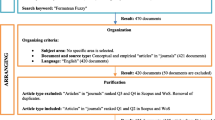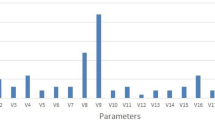Abstract
Attribute reduction and reducts are important notions in rough set theory that can preserve discriminatory properties to the highest possible extent similar to the entire set of attributes. In this paper, the relationships among 13 types of alternative objective functions for attribute reduction are systematically analyzed in complete decision tables. For inconsistent and consistent decision tables, it is demonstrated that there are only six and two intrinsically different objective functions for attribute reduction, respectively. Some algorithms have been put forward for minimal attribute reduction according to different objective functions. Through a counterexample, it is shown that heuristic methods cannot always guarantee to produce a minimal reduct. Based on the general definition of discernibility function, a complete algorithm for finding a minimal reduct is proposed. Since it only depends on reasoning mechanisms, it can be applied under any objective function for attribute reduction as long as the corresponding discernibility matrix has been well established.



Similar content being viewed by others
References
An A, Shan N, Chan C et al (1996) Discovering rules for water demand prediction: an enhanced rough set approach. Eng Appl Artif Intell 9(6):645–653
Asuncion A, Newman DJ (2007) UCI machine learning repository. University of California, Irvine, CA. http://archive.ics.uci.edu/ml/
Beynon M, Peel MJ (2001) Variable precision rough set theory and data discretization: an application to corporate failure prediction. Int J Manag Sci Omega 29:561–576
Chang LY, Wang GY, Wu Y (1999) An approach for attribute reduction and rule generation based on rough set theory. J Softw 10(11):1206–1211 (in Chinese)
Deng DY, Huang HK, Li XJ (2007) Comparison of various types of reductions in inconsistent systems. Acta Electron Sin 35(2):252–255 (in Chinese)
Dimitras AI, Slowinski R, Susmaga R et al (1999) Business failure using rough sets. Eur J Oper Res 114:263–280
Hu XH, Cercone N (1995) Learning in relational databases: a rough set approach. Int J Comput Intell 11(2):323–338
Jelonek J, Krawiec K, Slowinski R (1995) Rough set reduction of attributes and their domains for neural networks. Int J Comput Intell 11(2):339–347
Komorowski J, Pawlak Z, Polkowski L, Skowron A (1999) Rough sets a tutorial. In: Pal SK, Skowron A (eds) Rough fuzzy hybridization: a new trend in decision-making. Springer, Singapore, pp 3–98
Kryszkiewicz M (1998) Rough set approach to incomplete information systems. Inform Sci 112:39–49
Kryszkiewicz M (2001) study of alternative types of knowledge reduction in inconsistent systems. Int J Intell Syst 16:105–120
Li DY, Zhang B (2004) On knowledge reduction in inconsistent decision information systems. Int J Uncertain Fuzziness Knowl Based Syst 12(5):651–672
Liang JY, Shi ZZ, Li DY et al (2006) Information entropy, rough entropy and knowledge granulation in incomplete information systems. Int J Gen Syst 35(6):641–654
Liang JY, Wang BL, Qian YH et al (2008) An algorithm of constructing maximal consistent blocks in incomplete information systems. Int J Comput Sci Knowl Eng 2(1):11–18
Leung Y, Li DY (2003) Maximal consistent block technique for rule acquisition in incomplete information systems. Inform Sci 153:85–106
Mi JS, Wu WZ, Zhang WX (2004) Approaches to knowledge reduction based on variable precision rough set model. Inform Sci 159:255–272
Miao DQ, Wang J (1997) Information-based algorithm for reduction of knowledge. In: Proceedings of the 1997 IEEE international conference on intelligent processing systems (ICIPS’97), 28–31 October, Beijing, China, pp 1155–1158
Miao DQ, Zhao Y, Yao YY et al (2009) Relative reducts in consistent and inconsistent decision tables of the Pawlak rough set model. Inform Sci 179:4140–4150
Miao DQ, Zhou J, Zhang N et al (2010) Research of attribute reduction based on algebraic equations. Acta Electron Sin 38(5):1021–1027 (in Chinese)
Nguyen SH, Nguyen HS (1996) Some efficient algorithms for rough set methods. In: Proceedings of the sixth international conference on information processing and management of uncertainty in knowledge-based systems (IPMU’96), 1–5 July, Granada, Spain, pp 1451–1456
Nguyen HS, Slezak D (1999) Approximation reducts and association rules correspondence and complexity results. In: Zhong N, Skowron A, Oshuga S (eds) Proceedings of RSFDGrC’99, Yamaguchi, Japan, LNAI 1711, pp 137–145
Pawlak Z (1982) Rough sets. Int J Comput Inform Sci 11(5):341–356
Pawlak Z, Wong SKM, Ziarko W (1988) Rough sets: probabilistic versus deterministic approach. Int J Man Mach Stud 29:81–95
Pawlak Z, Skowron A (2007) Rudiments of rough sets. Inform Sci 177(1):3–27
Pedrycz W (2007) Granular computing—the emerging paradigm. J Uncertain Syst 1(1):38–61
Pedrycz W, Skowron A, Kreinovich V (2008) Handbook of granular computing. John Wiley & Sons Inc., New York
Qian YH, Liang JY, Wang F (2009) A new method for measuring the uncertainty in incomplete information systems. Int J Uncertain Fuzziness Knowl Based Syst 17(6):855–880
Qin KY, Pei Z, Du WF (2005) The relationship among several knowledge reduction approaches. FSKD 2005, LNAI 3613, pp 1232–1241
Skowron A, Rauszer C (1991) The discernibility matrices and functions in information systems. In: Slowinski R (eds) Intelligent decision support handbook of applications and advances of the rough sets theory. Kluwer Academic Publishers, Dordrecht, pp 331–362
Slezak D (2000) Various approaches to reasoning with frequency based decision reducts: a survey. In: Rough set methods and applications: new developments in knowledge discovery in information systems. Physica-Verlag Gmbh, Heidelberg, pp 235–285
Starzyk JA, Nelson DE, Sturtz K (2000) A mathematical foundation for improved reduct generation in information systems. Knowl Inform Syst 2:131–146
Thangavel K, Pethalakshmi A (2009) Dimensionality reduction based on rough set theory: a review. Appl Soft Comput 9:1–12
Wang CZ, Wu CX, Chen DG (2008) A systematic study on attribute reduction with rough sets based on general binary relations. Inform Sci 178:2237–2261
Wang GY, Yu H, Yang DC (2002) Decision table reduction based on conditional information entropy. Chin J Comput 25(7):759–766 (in Chinese)
Wang GY (2003) Rough reduction in algebra view and information view. Int J Intell Syst 18:679–688
Wang GY, Zhao J, Wu J (2005) A comparative study of algebra viewpoint and information viewpoint in attribute reduction. Fund Inform 68(3):289–301
Wang J, Miao DQ (1998) Analysis on attribute reduction strategies of rough set. J Comput Sci Technol 13(2):189–193
Wang J, Wang J (2001) Reduction algorithms based on discernibility matrix: the order attributes method. J Comput Sci Technol 16(6):489–504
Wong SKM, Ziarko W (1985) On optimal decision rules in decision tables. Bull Polish Acad Sci 33(11–12):693–696
Xu ZY, Liu ZP, Yang BR et al (2006) A quick attribute reduction algorithm with complexity of \(\max(O(|C||U|), O(|C|^2|U/C|))\). Chin J Comput 29(3):391–399 (in Chinese)
Xu ZY, Yang BR, Song W et al (2008) Comparative research of different attribute reduction definitions. J Chin Comput Syst 5(5):848–853 (in Chinese)
Yao YY, Zhao Y, Wang J (2006) On reduct construction algorithms. In: Proceedings of the first international conference on rough sets and knowledge technology (RSKT’06), 24–26 July, Chongqing, China, pp 297–304
Yao YY, Zhao Y (2009) Discernibility matrix simplification for constructing attribute reducts. Inform Sci 179(7):867–882
Yao YY, Zhao Y, Wang J et al (2008) A model of user-oriented reduct construction for machine learning. Transactions on rough sets VIII. Springer, Berlin, LNCS 5084, pp 332–351
Yao YY, Zhao Y (2008) Attribute reduction in decision-theoretic rough set models. Inform Sci 178:3356–3373
Ye DY, Chen ZJ (2006) An improved discernibility matrix for computing all reducts of an inconsistent decision table. In: Proceedings of the fifth IEEE international conference on cognitive informatics (ICCI’06), 17–19 July, Beijing, China, pp 305–308
Zakowski W (1993) Incomplete information systems. Bull Polish Acad Sci Tech Sci 41(2):175–181
Zhang WX, Mi JS, Wu WZ (2003) Approaches to knowledge reductions in inconsistent systems. Int J Intell Syst 18:989–1000
Zhao Y, Yao YY (2007) Data analysis based on discernibility and indiscernibility. Inform Sci 177:4959–4976
Zhao Y, Luo F, Wong SKM, Yao YY (2007) A general definition of an attribute reduct. In: Proceedings of the second rough sets and knowledge technology (RSKT’07), 14–16 May, Toronto, Canada, pp 101–108
Acknowledgments
The authors are grateful to the anonymous referees for their valuable comments and suggestions. This work is supported by National Natural Science Foundation of China (Serial Nos. 60475019, 61075056, 60970061) and the research fund for the Doctoral Program of Higher Education in China (Serial No. 20060247039).
Author information
Authors and Affiliations
Corresponding author
Rights and permissions
About this article
Cite this article
Zhou, J., Miao, D., Pedrycz, W. et al. Analysis of alternative objective functions for attribute reduction in complete decision tables. Soft Comput 15, 1601–1616 (2011). https://doi.org/10.1007/s00500-011-0690-7
Published:
Issue Date:
DOI: https://doi.org/10.1007/s00500-011-0690-7




